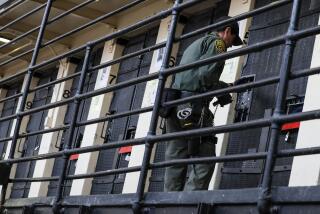Editorial: Gavin Newsom’s death penalty moratorium could turn the abolitionist tide in California

Gov. Gavin Newsom discusses the death penalty.
Gov. Gavin Newsom’s decision to suspend executions in California for as long as he is governor is, for the time being, a symbolic act. No one has been executed in San Quentin’s death chamber since Jan. 17, 2006, and few believe the next execution would have happened any time soon, given the array of legal hurdles embroiling the system. But Newsom’s moratorium — technically, he granted reprieves to each of the 737 people on death row — at a minimum adds further delays to the resumption of the machinery of death, as U.S. Supreme Court Justice Harry A. Blackmun once described it. And that’s a good thing.
Newsom cited his family’s connection with Peter Pianezzi, who was convicted in 1940 of a mob hit but later cleared and whose campaign for a pardon was championed by Newsom’s father and grandfather. That led to the evolution of a personal rejection of the death penalty. “I can’t sign my name to that,” he said. “I can’t be a part of that.”
Even before Newsom announced the moratorium Wednesday, critics were already complaining that his action thwarts the will of voters, something he promised during his campaign to respect. In 2016, Californians rejected a ballot measure to end the death penalty and convert existing sentences to life in prison without parole, narrowly approving instead a competing measure to speed up the process.
California’s modern history reflects a population that recognizes that the criminal justice system has been too harsh on the poor and minorities.
The state Supreme Court later gutted a key element of the winning initiative, ruling that provisions that would have compelled the courts to adhere to a tight schedule for death penalty appeals were unenforceable. So things remain pretty much as they were before that 2016 vote, which offers clear evidence that the hurdles in crafting a constitutional, effective and reliable system to determine innocence or guilt in capital cases, and thus life or death, in a just manner are insurmountable regardless of the will of the people.
Meanwhile, Assemblyman Marc Levine (D-San Rafael) on Wednesday introduced a measure that would put on the 2020 ballot yet another initiative to ban the death penalty. In the wake of Proposition 66’s inability to deliver on it backers’ promises, the voters ought to have a chance to change their minds.
Newsom also announced that he would close the death chamber at San Quentin and scrap the state’s proposed single-drug lethal injection protocol, leaving the state without any court-approved methods to carry out a death sentence. These steps, too, may be less significant than they seem. Shutting down a death chamber that isn’t being used is easy, and the proposed injection protocol is still hung up in the courts.
Nevertheless, death penalty advocates are likely to challenge the withdrawal of the proposed execution protocol. So be it. But note that for more than a decade since a federal judge ruled that California’s lethal-injection protocol was cruel and unusual punishment, the state has been unable to craft a constitutional method for killing people. That should tell us something.
Meanwhile, the will of the people has been shifting. Last year, California juries imposed only five death sentences, down from 11 the year before and from a peak of 43 death sentences in 1999. As more capital punishment cases get deeper reviews by opponents of capital punishment, more and more people — 164 since 1973 — are being exonerated and released from death rows nationwide, including five in California. Newsom already had expanded DNA testing in the highly questionable 1985 conviction of Kevin Cooper that could lead to a sixth exoneration. And about half of the exonerated nationwide are African American, evidence that the system disproportionally affects minorities.
California’s modern history reflects a population that recognizes that the criminal justice system has been too harsh on the poor and minorities. That recognition has led to landmark sentencing reforms under Propositions 47 and 57. In that regard, support for Proposition 66 was an outlier for California voters, and it’s perplexing why a populace that recognizes the unfairness in some portions of the criminal justice system still has faith in that part of a system that can lead to the executions of our fellow Californians.
Enter the Fray: First takes on the news of the minute »
Death sentences imposed in California are no less arbitrary than elsewhere. A killing that would have led to a non-capital murder charge in Los Angeles would in the recent past have likely been a death penalty case in neighboring Riverside County, a measure of the unjustifiable geographic variation in the application of capital punishment. And that a change in district attorneys in Riverside County led to a significant decrease in capital cases is further evidence that the impulses of prosecutors have an inordinate influence on who gets a death sentence. You can’t get much more arbitrary than that.
Admittedly, a governor announcing he will not enforce specific aspects of certain laws leads us into uncomfortable territory too. But Newsom has unlimited authority to grant reprieves to death row inmates, so he appears to be on solid ground here.
It’s good that the governor has pulled the plug on executions, at least for the time being. Now we need to get on to the business of ending capital punishment — here and in every other state — once and for all.
Follow the Opinion section on Twitter @latimesopinion or Facebook
More to Read
A cure for the common opinion
Get thought-provoking perspectives with our weekly newsletter.
You may occasionally receive promotional content from the Los Angeles Times.










